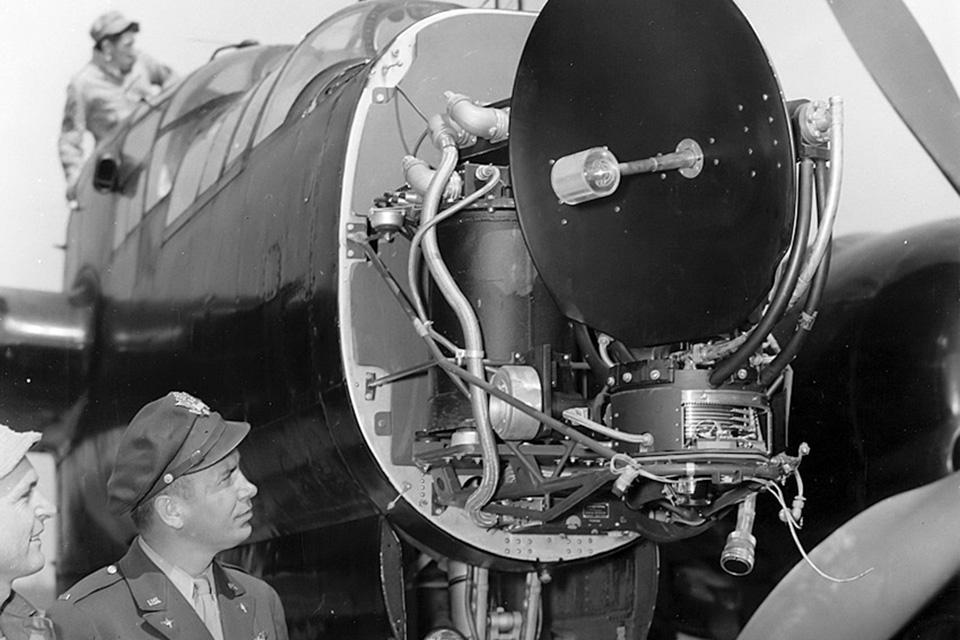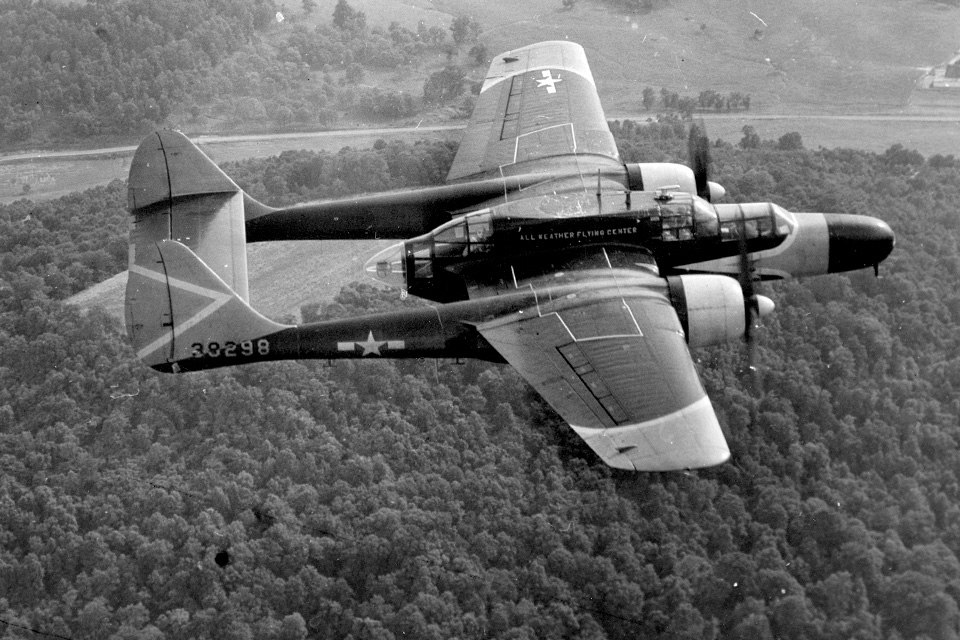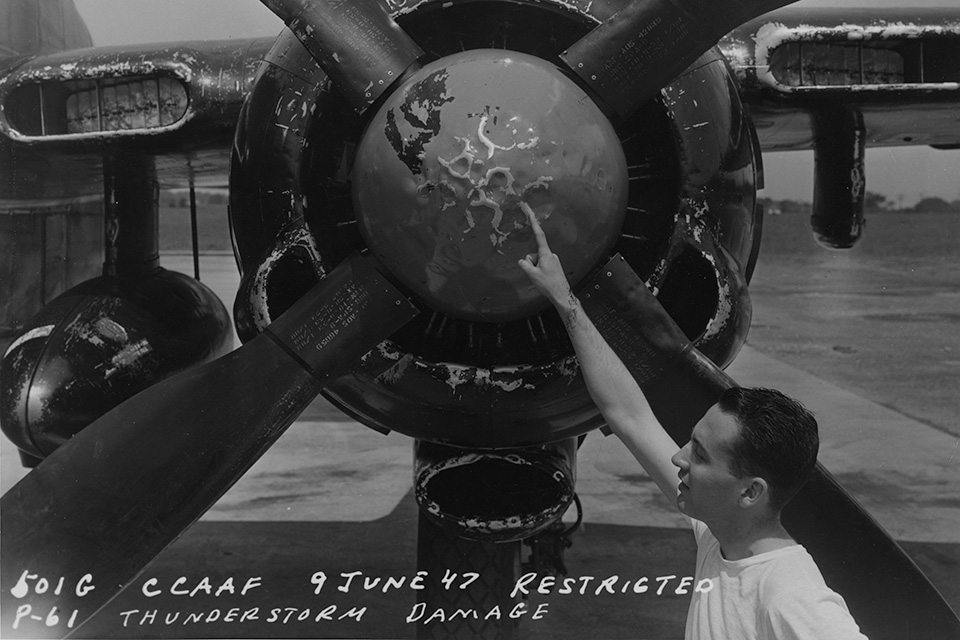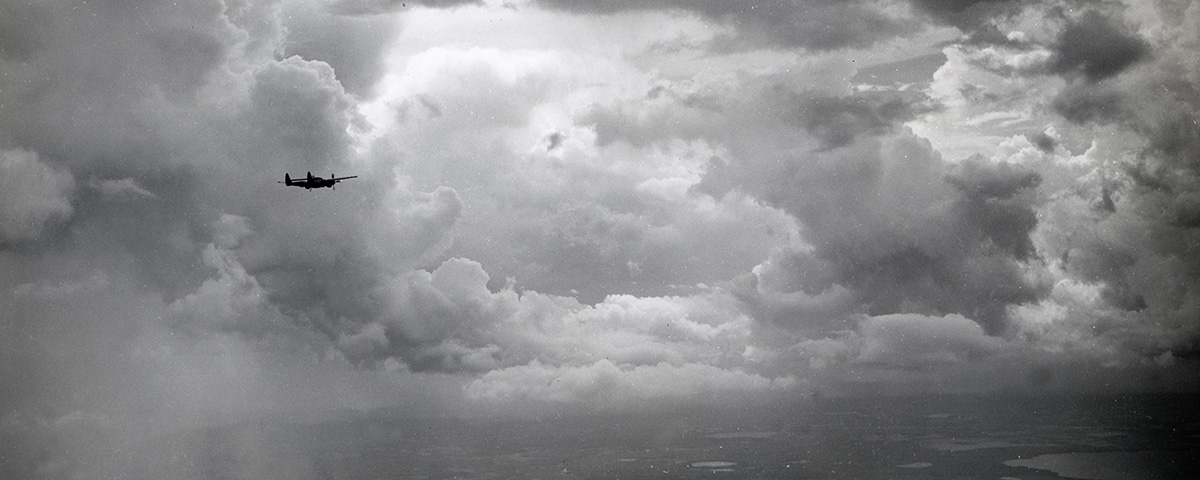The Witch of November was laying down the law. An ominous weather front whipped the iron-green waters of Lake Erie into a froth. The lead-colored sky grew darker as a severe thunderstorm began discharging thousands of volts in all directions. The cracking sounds of thunder traveled from one side of the horizon to the other. Yet while seemingly saner people sought cover from the impending deluge, a group of military pilots prepared to fly directly into this cacophony.
At the time, the raw power and inner workings of thunderstorms were poorly understood. In 1945 Congress sought to redress that deficiency by mandating and funding a multi-agency meteorological study. A group of brave airmen stepped forward in the interest of science to help peel back the layers of mystery surrounding severe weather. Dubbed the Thunderstorm Project, the joint venture involved no less than four federal agencies: the Weather Bureau, the National Advisory Committee for Aeronautics (NACA, the predecessor of NASA), the Army Air Forces and the Navy.
In August 1945, the Weather Bureau appointed University of Chicago meteorologist Horace R. Byers director of the Thunderstorm Project. With World War II over, a surplus of trained personnel, aircraft and equipment created the ideal conditions to launch the project. The war’s end also saw a corresponding increase in the number of weather-related civil aviation accidents, providing additional impetus for the in-depth study.
The Thunderstorm Project’s main objective was to get inside a severe weather event to assess its characteristics and the dangers it held. Central Florida, the frequent site of violent thunderstorms, became a logical place for the storm study to begin in the summer of 1946. The airmen participating in the program were based at Pinecastle Army Airfield near Orlando. The following summer the project was moved to Wilmington, Ohio, and headquartered at the All-Weather Flying Center at Clinton County Army Air Force Base.

It was an important study for its time, on a par with postwar atomic bomb testing then taking place in the South Pacific. The aircraft chosen for the project, surplus Northrop P-61C Black Widows, flew as many missions through thunderstorms as possible during different phases of severe weather events. The P-61Cs would enter the storm at different altitudes in a vertical stack, 5,000 feet apart, to obtain the broadest spectrum of measurements possible.
It was dangerous flying, with few dull moments. Roscoe R. Braham Jr., a senior analyst with the Thunderstorm Project, said the goal was “to obtain the maximum number of traverses through each storm and to sample storms in all stages of development. No storm was to be avoided because it appeared too large or violent.”
Each Black Widow carried a crew of three: an accomplished instrument pilot, a highly trained radar operator and a weather observer. The military pilots were members of Air Materiel Command’s All-Weather Flying Division, and underwent careful screening to ensure they were well suited to the program. In addition to their volunteer spirit, the crews had to project a high level of alertness and confidence and be unfazed by the unexpected dangers of such hazardous research.
These particular Black Widows were obtained from a weather reconnaissance outfit being terminated in Alaska, the Cold Weather Testing Detachment, Unit 616, based at Ladd Army Airfield near Fairbanks. The twin-engine P-61 was chosen for the study largely because of its sturdy construction, durability and onboard radar. NACA engineers equipped the Black Widows with instruments to measure their response to turbulence, and installed transponders so they could be tracked. In effect, the entire airplane was a storm turbulence sensor.

To supplement the Black Widows, the Soaring Society of America loaned the Thunderstorm Project three Pratt-Read TG-32 two-seat gliders for exploration of smaller cumulus clouds. This group of pilots made 141 flights under a contract with the Weather Bureau, and on numerous occasions flew into full-stage thunderstorms—frightening conditions for a glider ride! During one flight, pilot Paul Tuntland was caught inside a powerful thunderstorm updraft over Florida on July 25, 1946, that took him from his release point at 4,000 feet up to 22,700 feet, setting a new national altitude record for two-place gliders.
The Thunderstorm Project also used a variant of the P-61, the F-15 Reporter, to take close-up photographs of thunderstorms and make complete reconnaissance flights around them. A movie camera, controlled by the pilot, was installed in the Reporter’s nose section. Ground radar would track the F-15 as it circled a thunderstorm, giving the storm cell’s exact dimensions and location.
Engineers checked all the onboard recording equipment before and after every flight. The turbulent flying conditions could easily play havoc with instrumentation, so technicians took no chances with these delicate devices.
Pilots were instructed to set the airplane trim for straight and level flight prior to entering a thunderstorm, and to exert minimal control input once they had penetrated the storm. Power settings and control surface movements were constantly recorded, and instrument panels filmed. Considering the severe conditions inside the thunderclouds, and the P-61s’ dramatic reactions to violent updrafts and downdrafts, getting usable film footage was not easy. Motion picture film of a Black Widow’s instrument panel as it flew through a storm cell showed the needles on the horizon and altimeter gauges jumping all over the place.
As might be expected, the P-61s took a beating. One Black Widow was upended onto its back during a mission, but the pilot managed to recover. Another pilot issued a radio report of heavy, blinding snow inside a storm cloud. Several aircraft were struck by lightning, hail and ice. P-61 nose cones were punched in by the weather and propellers were bent and dented. In spite of such punishment, there were no accidents or fatalities during the project, which encompassed 1,362 cloud penetration flights.

About 180 hard-working men and women participated in the Thunderstorm Project from 1946 to 1949, helping to greatly advance the science of meteorology. Today’s understanding of thunderstorms owes much to their efforts, and aviation is far safer for it. Data collected during the project showed that even light aircraft can structurally withstand the wrath of storms, and that with proper instrumentation and training a pilot could minimize the risk of encountering turbulence and strong vertical motion.
The Thunderstorm Project was the first study to determine that radar should play a front and center role in helping pilots navigate in and around storm cells, depending on the severity of the weather. Dave Atlas, one of the pioneers of radar meteorology, was a key figure in getting radar into the cockpits of aircraft for practical use. The Thunderstorm Project also helped spur development of ground-based weather radar used for general aviation and more.
As for the brave airmen who volunteered to fly their Black Widows into the teeth of violent thunderstorms, they emerged with a new appreciation for the power of Mother Nature. For their efforts they were all awarded the Distinguished Flying Cross.
Today we take for granted such modern developments as Doppler radar and computer-generated storm modeling. Most people don’t realize that the push to develop those tools began with the Thunderstorm Project, and that the hard data it collected on the life cycle of severe storms laid the foundation for modern forecasters and helped make the skies safer for all.
Steve Zuger is a freelance writer and teacher based in Salem, Ore. He wishes to thank Mike Kurz, a meteorologist with the National Weather Service in Wilmington, Ohio, for his assistance with this article. For more about the Thunderstorm Project, including a 35-minute Department of Defense video chronicling the Ohio phase, visit weather.gov/iln/thunderstormproject.
This feature originally appeared in the July 2015 issue of Aviation History. Subscribe here!

